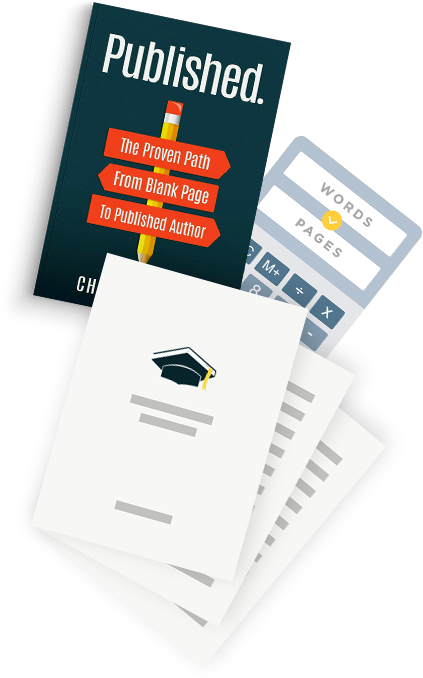Spooky books are great all year long, but especially during the fall, where the elements of a scary story are only enhanced by the darker days and colder weather. Even just here, I’ve exposed an element that can add to your scary story; darkness. But that’s not one you can control, right?
As a writer, you only have so much to work with when it comes to telling your story. Words on a page can only be rearranged in so many ways. Thankfully, the human mind conjures the rest, and that’s what we’re here to talk about:
Not necessarily how you can write scarier books, but how you can use the elements of a scary story to get the reader to create the fear in their own mind.
Elements of a Scary Story to Make Readers Tremble:
Brain Chemicals and Fear: A Writer’s Toolset
Writing produces emotions in people. We know this. You know this! It’s why readers reader; to feel something other than what they currently have access to experience in real life. But how do those emotions end up happening?
Well, brain chemicals. An author writers words, a reader consumes them, and then the reader hallucinates, lighting up real emotional centers of their brain as if they are experiencing something. Even just reading a word like “coffee” or “perfume” can cause a reader’s olafactory (odor) cortex light up.
When an author uses the right combination of mental images (with imagery), it can create real fear for readers—among other emotions like sadness, longing, love, and arousal being one many romance and erotica writers in particular capitalize on. This is because when readers read, they put themselves in the situations of the main character. They’re experiencing the story as the main character (even if it’s not first person point of view).
If you’re writing a book that’s meant to produce fear, you have to understand what fear is.
The definition of fear is: an unpleasant emotion caused by the belief that someone or something is dangerous, likely to cause pain, or a threat.
Therein lies at least 3 elements of a scary story you can use in various means to get your readers reaching to turn on the light.
7 Most Important Elements of a Scary Story & How to Incorporate Them in Yours
Based on the definition above, we know that fear is caused when someone is being faced with danger, pain, or potential threats. Essentially, when we (as readers) recognize that a character is about to be put in danger, we will feel fear because we’re transposing the state of the character onto ourselves at that moment.
1. A Likable Character
First and foremost, your scary story has to be through the perspective of someone the reader likes and therefore won’t want harm to come to. If you create a character who’s mean or a jerk, the reader will only rejoice when terrible things happen. Then it’s not a scary story.
So work on your character development so the reader likes the main character.
But remember that “likable” doesn’t always have to mean they’re a really nice person. You don’t want a jerk, but you can write a character with less than awesome moral standards if they have other qualities.
Here are a few things you can do to make a character likable:
- Make them sympathetic (make the reader feel bad for them): this is popular in stories like Harry Potter where he’s the innocent, helpless kid.
- Make them a nice person
- Have other character in the book like this person (because people tend to like someone who others really like)
- Make them really talented or skilled in something: this is an area where you can make your character possibly less likable in terms of personality, but likable in terms of the reader wanting to see them succeed—they want to root for a capable character and don’t want bad things to happen to them
Prioritize this as much of any of the other elements of a scary story. If we don’t care about the character, we won’t care about what happens to them.
2. Safety
Without knowing what “safe” is for the main character, the rest of the elements of a scary story won’t be nearly as potent. We have to understand the baseline.
This will shape the beginning of the book—before the inciting incident—also known as the introduction. The more you can set up the book to be hopeful and happy, the more opportunity for fear due to its potential loss.
This should include the environment the main character has before all goes bad: It should be comfortable, and hopeful. Whatever goals they have are looking up, the new house is nicer than they imagined, and they’re in a safe place in life regarding their relationships, friendships, family, etc.
3. Stakes
The safety of the character will contribute to the stakes of the story, but you have to be clear about what’s at stake. What can the character lose based on the type of story you’re telling?
You can show this in a few ways:
- Talk about what the main character actually fears
- Show a danger or threat in the town or area (like a serial killer on the loose in the town they move to, as a more basic example)
- Show an opportunity for the main character to lose something (like if the house they’re moving into may need renovations)
- Give your main character something they’re already worried about
- Give your main character something new and good that they care deeply about (because readers will understand that this is what they might lose)
Setting the stakes in a story can be tricky. It usually boils down to genre, the introduction, and how well you establish what the main character truly cares about. If they just got a new job in a new town and are concerned with doing well and proving themselves, then obviously what’s at stake is them doing a good job.
Therefore, you can craft the elements of a scary story around this character failing to do their job well.
4. Danger
Any scary story needs danger. What that danger actually is depends on the genre of your book. Horror will have different dangers than supernatural or other subgenres of scary stories. But it will also have to do with your character and what’s dangerous to them in the plot.
We’ve all ready many stories where someone moves into an old house, rumored to be dangerous for various reasons. When that information is set up well in the introduction of your story, you’ll be able to create the dangers from there.
Remember, when it comes to elements of a scary story, the danger actually moves the plot forward. The moments where the plot gets dangerous is where tension lies, and that tension increases the pacing along with the reader’s heart rate.
When it comes to placing this danger in scary stories, think about the turning points. When writing a novel, there are 5 milestones you can follow. Danger should be present at all of them because these are the moments when the stakes are high and we need the main character to “lose”.
5. Pain
There are two primary types of pain to think about when using the elements of a scary story. The first is what we usually think of: physical pain.
Have you ever watched those videos where another person is getting hurt—falling, cutting themselves, etc.—and you can’t help but wince? You’re not actually being harmed, but you tense up as if the pain is happening to you. This is because of your mirror neurons, and is the same process of imposing emotional events of the character onto yourself. This works well for scary stories because if your character is injured, the reader will fear repeated injury. Even threats of pain (which we’ll cover below) that are detailed enough can illicit the same emotions.
The other type of pain is emotional, and is much more specific to the character you’ve crafted and also involves the stakes of the story. Fear of losing something valuable to you—person, job, sentimental item—can create a lot of fear. When you’ve established the stakes or what the character wants and you take that away (especially through scary means), you’ll create the fear you want.
6. Threats
For the few elements of a scary story above, one of the best things you can do is threaten them. More than those dangers or pain actually happening, the threat of those elements of a scary story will create the fear you want.
That’s why threats are so effective. It can be the threat of losing a job, the threat of losing a limb or life, the threat of someone the characters loves being harmed, etc. One way you can integrate these fears into your story is to use other characters or the unknown (covered below) to threaten what the main character loves most.
In many scary stories, this can be presented by a rumor of the town. It can be from smaller acts of danger and pain, and even a close-call for what the main character loves most.
In fiction, seeing something dangerous happening to something or someone that closely resembles what the main character loves, even if it doesn’t effect them, will be felt as a threat and will create fear in the reader.
7. The Unknown
This is where darkness would fall. It’s also where questions can arise within the plot. What’s worse than a danger you can see and are aware is lurking out there?
A danger you don’t know or can’t see what it looks like.
This is why there are plenty of scary stories with serial killers who are someone the main character has been around. There are enough clues to know that this killer has been near them, but not enough for us to know who. This is also the case with any stories of people being harmed or killed in the woods by something. The fact that we don’t know what it is makes any scene in which the main character ventures into the woods that much more scary. You can also find psychological thrillers in which the scary part is the fact that the reader never really knows what’s true or what’s a lie within the psychosis.
If you answer every question the reader is asking right away, you lose this effect, and it’s one of the best elements of a scary story to use because it also keeps the reader flipping pages and consuming your book. Just remember that you do eventually have to make that unknown come to light.
7 Examples of Scary Stories + The Elements That Make Them Nail-Biters
As I always say, the best way to learn is to read and discover why it is certain elements of a scary story work effectively. These examples will help you figure it out.
1.The Tell-Tale Heart by Edgar Allan Poe
This story is told from the perspective of a narrator who insists on their sanity while describing their murder of an old man with a “vulture eye.” The relentless build-up of tension and the narrator’s descent into madness create a chilling atmosphere. The sound of the old man’s beating heart beneath the floorboards, which the narrator believes is growing louder and louder, adds to the psychological horror.
2. The Exorcist by William Peter Blatty
This novel revolves around the possession of a young girl, Regan, by a horrid demon. The graphic descriptions of Regan’s transformation, along with the attempts at exorcism, tap into primal fears of the unknown and the loss of control over one’s own body, which is something any reader will be able to fear.
3. The Shining by Stephen King
Stephen King is one of the most prolific teller of scary stories. His novels are packed with the elements of a scary story, so he’s a perfect author to read if you want to write chilling books.
This story specifically takes place in a secluded, haunted hotel where a caretaker, Jack Torrance, succumbs to the malevolent forces within. The isolation, the creeping dread, and Jack’s loss of sanity create an intense psychological horror. The idea of being trapped with an increasingly unstable individual is deeply unsettling, and this fear is easily translated to the reader.
4. The Lottery by Shirley Jackson
This short story portrays a small town where an annual lottery results in the stoning of a member of the community. The ordinariness of the setting and the casual acceptance of violence and cruelty evoke a sense of pervasive, insidious horror. It uses the elements of a scary story well, with the threat of violence always looming and the danger the lottery can include. Not to mention the pain involved. It’s a commentary on the potential darkness that lurks beneath the surface of seemingly normal societies, and bubbles up the unknown we all feel at times about others and society as a whole.
5. The Turn of the Screw by Henry James
This novella tells the story of a governess who becomes convinced that the children she cares for are being haunted by evil spirits. The ambiguity surrounding whether the ghosts are real or a product of the governess’s imagination creates a sense of unease, and also uses one of the elements of a scary story well with the use of the unknown. The idea of not being able to trust one’s own perceptions also creates the threat of danger.
6. Ring by Koji Suzuki
The story centers around a cursed videotape that brings a evil ghosts into the lives of those who watch it. The idea of a countdown to impending doom, combined with the relentless pursuit of the vengeful spirit, taps into primal fears of mortality and the unknown. Plus, there are plenty of threats to go around.
7. The Strain by Guillermo del Toro and Chuck Hogan
This novel involves a viral outbreak that turns humans into vampire-like creatures, invoking danger and pain elements of a scary story. The rapid spread of the virus, the transformation of familiar figures into monstrous entities, and the struggle for survival in a world rapidly falling apart create a visceral sense of horror.
Specifically, the fact that one is always under threat is particularly harrowing in this story. Either you’re threatened by becoming one of these creatures, or you’re threatened by them in general.
The elements of a scary story often come together in various ways. You can focus on using a little of all of them, or you can focus on one or two and write a novel around just those.



